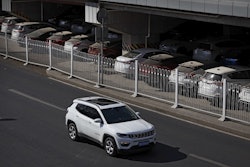Continued from Part 1. This conversation has been edited for length and clarity.
MNET: What do warehouse managers need to know about potential pain points when it comes to safety and automation?
Adam Kline: When you’re talking about traditional conveyance and automation, those things don’t move. There are safety mechanisms if you need to get to one side of the conveyor to another, and as soon as you lift a section it shuts the whole conveyor down until you can put the bridge back down. There are a lot of safety measures in place for that static automation. But when you think about automated forklifts, AGVs, or collaborative robots, now you’re deploying a potentially large number of these robots. It’s usually twenty or 30 or more, and those are going to be interacting with the people. If you look at the evolution of these bots, the initial bots had to be in their own area and you didn’t see humans and bots interacting. The new ones have an array [of safety sensors].
As we were having a stand-up meeting there [at Locus] we were in their test warehouse where these things are out and about. There was a bot that came up to us and wanted to get to where we were standing. It would stop, pause, and realize it couldn’t get through. So it was almost as if it was saying excuse me. Eventually it left. Then it came back and patiently waited, stood there a little closer and a little longer. Then it went away and came back. It stood there again and finally we moved, and it was almost as if it said thank you and patiently went about what it wanted to do.
Compared to those old Kiva bots, in terms of what Amazon has done with retrofitting some of its people with vests with RFID in them, and retrofitted the bots so they can interact a little bit. They’ve retrofit some obstacle avoidance. I don’t know how well that’s going to work out, but maybe it’ll help.
The other aspect is congestion. It has to be thought about. Some of our new capabilities include our take on waveless picking. It’s much more. It’s that orchestration of work we talked about before. Intelligent, cognitive work release engine. It helps balance the work across multiple resources so you don’t end up with high congestion on one side and under-utilized resources on the others. It’s helping divvy up that work, so to speak, as capacity opens up. It’s a systematic-driven way to achieve some of the points we talked about in terms of safety. It helps alleviate having people and robots bump into each other.
What are some signs that warehouse or supply chain managers should work on adding more automation?
When you were talking about workforce and people becoming harder to find, I think that’s certainly one. We have to start thinking of creative ways to either improve efficiency of the good workers we have or augment that with automation. The other is, as your volumes are growing, so we see customers all the time with one of two things happening: either their business is just growing, so their existing channels are growing and they just need to get more work out of a given facility in the same time, and automation can help alleviate that and give you more virtual capacity. The second, which is more interesting and a recent trend, is, say I’m a brand supplier [such as] footwear or apparel guys that provide brand shipping to retailers, or I could be a manufacturer providing goods to a wholesaler or direct. In both of those we’ve seen the same effect with ecommerce and direct consumer that oftentimes those suppliers are being asked to build out dropship programs on behalf of their retail customers. That requires a completely different way of driving fulfillment. Where you were once driving larger, bulk case quantities and often full pallets, now you’re talking about single item orders, maybe one or two units. That’s a much different operational proposition. Often when you bring in a new discipline like that, automation can help.
Or signs that their technology is getting in their way and should be streamlined?
We’ve been thinking about this a decent amount lately, and it’s interesting because we think of automation as a means to help things move more efficiently, [and to enable] hands-off decision making, like an ASRS [automated storage and retrieval system] for example. It’s making decisions of where to store goods, how to pull them out, etc. Some of our customers find that they outgrow their fixed resources. How do I deal with that? Some of our customers are looking at one of two solutions: either a different technology, different piece of automation, or augmenting it with something else on the side. Normally some of that technology has a pretty hefty price tag. So now that you’ve grown it, do you bring in another DC or bring in robotic tech to streamline the areas around it? There isn’t a great way to scale that fixed asset up. Make sure you’re planning well ahead, not for the volumes you have now but for the volumes ten years out. That’s one example.
The other example is somebody might be looking at something because it’s cool, it’s neat; that’s not the reason to procure technology. Sometimes somebody will put in something that their operations aren’t just ready for, or the technology just isn’t there. You end up with a Rube Goldberg machine.
Adam Kline is product director for warehouse management and supply chain intelligence at Manhattan Associates.



















